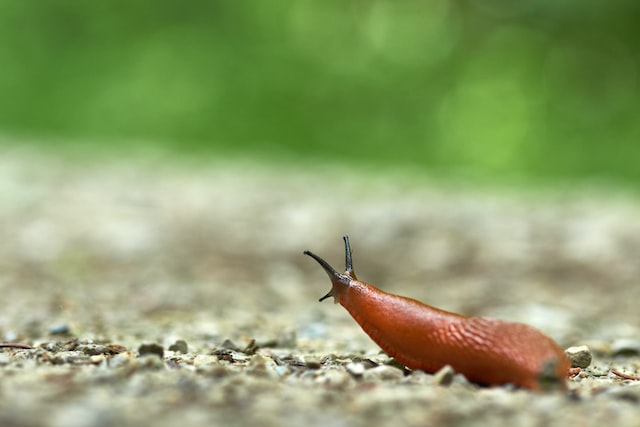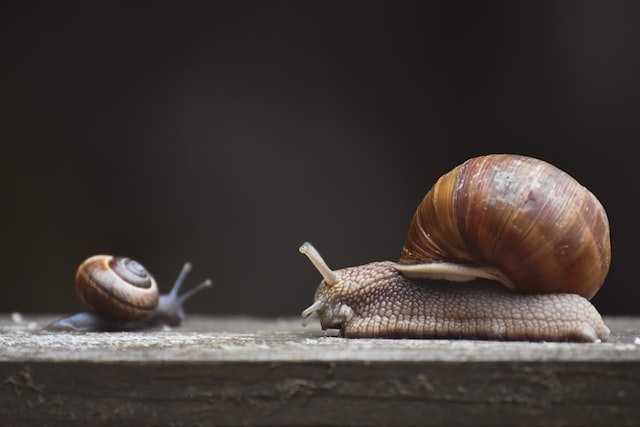The most obvious difference between slugs and snails is their appearance. Snails have a hard, coiled shell on their back, while slugs do not have a shell at all. This makes slugs much more vulnerable to predators and allows them to squeeze into tight spaces where snails cannot.
What are Slugs?
(Photo by Wolfgang Hasselmann on Unsplash )

Slugs are gastropods, or snail-like creatures, that do not have a shell. They have a soft, slimy body that is covered in mucus, which helps them to move around and protect their skin from drying out. Slugs have a single pair of tentacles that they use to sense their environment and detect potential threats.
What are Snails?
(Photo by Alexas_Fotos on Unsplash )

Snails are also gastropods but they have a spiral-shaped shell that they carry on their backs. This shell serves as a protection against predators and provides a moist, safe environment for the snail’s body. Snails also have two pairs of tentacles, with the larger pair serving as eyes and the smaller pair serving as olfactory organs.
Slugs Vs. Snails – Key differences
The most obvious difference between slugs and snails is their appearance. Snails have a hard, coiled shell on their back, while slugs do not have a shell at all. This makes slugs much more vulnerable to predators, but also allows them to squeeze into tight spaces where snails cannot.
Snails also have a retractable foot, which they use to move around. This foot is thick and muscular and helps the snail to grip onto surfaces and avoid slipping. Slugs, on the other hand, have a much thinner and flatter foot, which they use to glide smoothly along surfaces.
Another physical difference between slugs and snails is the shape of their body. Snails have a round, spiral body that is perfect for retracting into their shell for protection. Slugs, on the other hand, have a much more elongated and flat body that is more suited for moving through tight spaces.
Habitats of Slugs and Snails
Slugs and snails can be found in a variety of habitats, including forests, fields, gardens, and even in cities. Slugs are often found in damp and shady areas, while snails are typically found in more sunny and dry environments. Slugs are also more likely to be found in the ground, while snails are often found on trees, rocks, and other above-ground surfaces.
Reproduction of Slugs and Snails
Slugs and snails reproduce in different ways, with slugs laying eggs in clusters and snails laying eggs individually. Slugs can lay hundreds of eggs at a time, while snails typically lay only a few. Snails also have a more complex reproductive system, with both male and female snails having sexual organs, while most slugs are hermaphroditic and can self-fertilize.
Differences in Diet
Slugs and snails also have different dietary habits, with slugs being herbivores and snails being omnivores. Slugs feed on a variety of plants, including leaves, stems, and flowers, while snails feed on both plants and small insects and other animals. Snails have a radula, or a tongue-like structure, that they use to scrape food into their mouth, while slugs simply use their mouth to suck up food.
Protection from Predation
Slugs and snails have different methods of protecting themselves from predators. Slugs rely on their mucus and ability to hide in the ground to avoid being detected, while snails have their hard shells to protect them. Snails can also retract into their shells to make it harder for predators to get to them.
Physical Differences
The most obvious difference between slugs and snails is their appearance. Snails have a hard, coiled shell on their back, while slugs do not have a shell at all. This makes slugs much more vulnerable to predators, but also allows them to squeeze into tight spaces where snails cannot.
Snails also have a retractable foot, which they use to move around. This foot is thick and muscular, and helps the snail to grip onto surfaces and avoid slipping. Slugs, on the other hand, have a much thinner and flatter foot, which they use to glide smoothly along surfaces.
Another physical difference between slugs and snails is the shape of their body. Snails have a round, spiral body that is perfect for retracting into their shell for protection. Slugs, on the other hand, have a much more elongated and flat body that is more suited for moving through tight spaces.
Behavioral Differences
Slugs and snails also have different behaviors and habits. Snails are much more active at night, and will come out to feed on plants and other vegetation. They also tend to retreat into their shells during the day to avoid predators and extreme temperatures.
Slugs, on the other hand, are active both day and night, and feed on a wide variety of plants and other organic matter. They are also much more tolerant of sunlight, and will not retreat into a shell to avoid it.
Snails also lay their eggs in clusters, and will often hide them in damp, dark places where they are protected from predators. Slugs, on the other hand, lay their eggs individually, and will often bury them in soil or other hiding places.
Environmental Differences
The environment in which slugs and snails live can also have a significant impact on their behavior and habits. Snails are much more common in humid and damp environments, and are often found in gardens and near bodies of water. They prefer areas with high moisture levels and plenty of vegetation.
Slugs, on the other hand, are much more adaptable and can be found in a wide range of environments, including gardens, forests, and even deserts. They are also much more tolerant of extreme temperatures, and can survive in hot and cold climates.
Do slugs and snails damage your garden?
Yes, slugs and snails can damage gardens by eating plants, leaves, stems, and fruits. They are particularly attracted to tender young shoots and leaves.
Identifying Slug and Snail Damage
Before you can get rid of slugs and snails, you need to be able to identify their damage. This can often be difficult, as the pests are most active at night and are typically gone by the time you wake up in the morning. However, there are several signs that you can look for to identify slug and snail damage in your garden.
The most obvious sign of slug and snail damage is the presence of holes in your plants. These holes are typically round and smooth, with jagged edges that are characteristic of the pests’ rasping mouthparts. You may also notice slimy trails around the base of your plants or on the ground. These trails are left by the pests as they move around your garden.
Preventing Slug and Snail Damage
The best way to get rid of slugs and snails is to prevent them from getting into your garden in the first place. There are several effective ways to do this, including:
- Planting slug-resistant plants: Some plants are naturally resistant to slug and snail damage. These include plants with tough leaves, like lavender and rosemary, as well as plants with strong scents, like geraniums and scented pelargoniums.
- Creating barriers: Slugs and snails can’t cross certain barriers, like copper strips or sand. You can use these materials to create a barrier around your plants that will keep the pests out.
- Encouraging natural predators: Slugs and snails have many natural predators, including birds, frogs, and toads. Encouraging these predators to live in your garden will help to keep the pest population under control.
- Removing hiding places: Slugs and snails like to hide in dark, damp places. By removing these hiding places from your garden, you can make it less appealing to the pests.
How to Get Rid of Slugs and Snails
- Handpick: Collect and remove slugs and snails from the garden regularly.
- Barriers: Create physical barriers around plants using copper strips or mesh.
- Beer traps: Sink shallow containers filled with beer into the ground to attract and kill slugs and snails.
- Organic mulch: Apply organic mulch to garden beds to create an inhospitable environment for slugs and snails.
- Predatory insects: Encourage the presence of predatory insects, such as beetles and ground beetles, which feed on slugs and snails.
- Deterrent plants: Plant deterrent plants like alliums, fennel, and dill among others.
- Iron phosphate bait: Use iron phosphate-based slug and snail bait to kill them.
- Diatomaceous earth: Sprinkle diatomaceous earth around the garden as it dries out the slugs and snails.
How are slugs and snails beneficial for humans?
Slugs and snails are often considered pests, but they can also play a beneficial role in the environment and human life. By moving through soil, they help to aerate it and promote healthy plant growth. Additionally, they feed on flowers and contribute to pollination. Some species of snails are even consumed by humans in certain cultures as a source of food. Slugs and snails also break down dead plant material and other organic matter, helping to recycle nutrients back into the soil. They play a role in maintaining ecological balance in the environment by serving as a food source for other animals. Although they can cause damage to crops and gardens, slugs and snails can have a positive impact on the environment and human life.
What is the life cycle of a slug and snail?
The life cycle of a slug and snail includes the following stages:
- Egg laying: Slugs and snails lay their eggs in a moist environment, such as soil or under logs or rocks.
- Hatching: The eggs hatch into tiny, immature slugs or snails.
- Growth: Juvenile slugs and snails grow through several developmental stages, increasing in size as they feed on plants and other organic matter.
- Maturity: Slugs and snails reach sexual maturity in several months to a year and can live for up to several years.
- Reproduction: Slugs and snails are hermaphrodites and can mate with other individuals to produce eggs.
- Death: Slugs and snails die when they reach the end of their lifespan or when they fall victim to predators or environmental factors.
Are snail shells poisonous?
No, snail shells are not poisonous. Snail shells are made of calcium carbonate and other minerals, and are not toxic to humans or animals. However, it’s possible for snail shells to contain parasites or disease-causing organisms, so it’s important to wash them thoroughly before handling or consuming them. Additionally, some species of snails can produce toxins that can be harmful to humans and animals, so it’s important to be cautious when handling or consuming snails or their shells.
What are the types of snails?
There are many different types of snails, but here are a few of the most common ones:
- Garden snail: Also known as the common brown snail, this species is found throughout the world and is often considered a pest in gardens and crops.
- Giant African snail: This species is native to Africa, but has been introduced to many other parts of the world. It is one of the largest species of snails and can grow up to 20 cm in length.
- Roman snail: This species is native to Europe and is often hunted for food. It has a large, edible snail and is considered a delicacy in some cultures.
- Apple snail: This species is found in freshwater habitats and is often kept as an aquarium pet. It has a large, round shell and comes in a variety of colors.
- Conus snail: This species is a predatory snail that is found in marine habitats. It has a unique, cone-shaped shell and feeds on other mollusks and small fish.
- Helix snail: This is a genus of air-breathing land snails that includes many species, such as the common garden snail. Helix snails have a large, spiral shell and are found throughout the world.
These are just a few of the many types of snails found in the world. There are hundreds of species of snails, each with its own unique characteristics and habitats.
Do people eat snails and slugs?
Yes, some people do eat snails and slugs. Snails and slugs have been consumed by humans for thousands of years and are considered a delicacy in many cultures, especially in Europe and some parts of Asia. In these cultures, snails and slugs are commonly served in dishes such as escargot and are prepared in a variety of ways, including sautéing, baking, and grilling.
However, not everyone finds snails and slugs palatable, and some people may find the idea of eating them unappealing. Additionally, it is important to note that not all species of snails and slugs are safe to eat, as some can contain toxins or parasites that are harmful to humans. Before consuming snails or slugs, it is important to make sure that they have been properly cooked and that they come from a safe, reputable source.
Featured Image By – Photo by Krzysztof Niewolny on Unsplash








